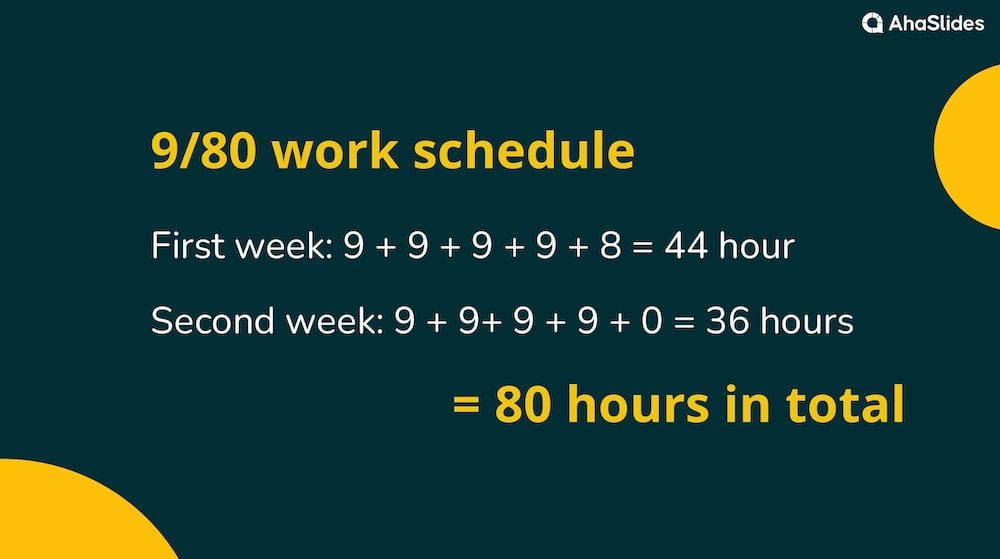昔ながらの9時から5時までの勤務スケジュールは、最近あまりにも退屈で窮屈だと感じたことはありませんか? 実は、あなただけではありません。多くの人が、何か新しいことに挑戦する時期が来たと考えています。
ますます多くの企業がこのことに気づき、通常の9時から5時までの仕事に代わる仕事を提供し始めています。
人気が高まっている選択肢の 80 つは、9/XNUMX 勤務スケジュールです。
あなたやあなたのチームに適しているかどうかわからないですか?ご心配なく、すべてご説明いたします。
どのように 9時から80時までの勤務スケジュール 働きやすさ、従業員と雇用主の両方にとっての長所と短所、そしてそれがあなたのビジネスに適しているかどうか。
目次
- 9時から80時までの勤務スケジュールとは何ですか?
- 80 時から 9 時までの作業スケジュールの例は何ですか?
- 9時から80時までの勤務スケジュールにはどのようなメリットがあるのでしょうか?
- 9時から80時までの勤務スケジュールの潜在的な欠点
- 主要なポイント(要点)
- よくある質問
エンゲージメントを高めるためのヒント

集会中の楽しみをもっとお探しですか?
AhaSlidesの楽しいクイズでチームメンバーを集めましょう。AhaSlidesテンプレートライブラリから無料のクイズにサインアップしてご参加ください!
🚀無料クイズをつかむ☁️
9時から80時までの勤務スケジュールとは何ですか?
9/80 勤務スケジュールは、 伝統的な9-5、週8日勤務では、月曜から金曜までXNUMX日XNUMX時間働く代わりに、 9日XNUMX時間働く XNUMX週間の勤務期間中に。
これは、80 週間ごとに合計 9 時間になります (9 日 x 81 時間 = 1 時間、残業時間 XNUMX 時間を差し引いたもの)。
隔週金曜日に休暇を取得できます フレックスデーつまり、1週間は月曜日から木曜日まで働き、次の週は月曜日から金曜日まで働くことになります。
これにより、隔週で 3 日の週末が得られるため、有給休暇を使用せずに実質的に追加の休暇を得ることができます。
通常、フレックスデーが各給与期間の同じ日に当たるようにスケジュールが設定されます。 これにより一貫性が維持されます。
計時は依然として標準に従っています 週40時間の労働 残業代に関する規定。 8 日あたり 80 時間を超える場合、または給与期間中に XNUMX 時間を超える場合、OT がトリガーされます。

80/9 勤務スケジュールの例は何ですか?
以下は、毎日 9 時間の昼休みがある 80/XNUMX 勤務スケジュールの例です。
| 週1 | 週2 |
| 月曜日 8:00 – 6:00 火曜日 8:00 – 6:00 水曜日 8:00 – 6:00 木曜日 8:00 – 6:00 金曜日の8:00 - 5:00 | 月曜日 8:00 – 6:00 火曜日 8:00 – 6:00 水曜日 8:00 – 6:00 木曜日 8:00 – 6:00 金曜休み |
9 時から 80 時までの勤務スケジュールを利用する一般的な業界には、次のようなものがあります。
官公庁 – 連邦、州、地方自治体の機関は、従業員に9時~80分の勤務時間を提供することがよくあります。例えば、運輸局、郵便局、公共事業部などが挙げられます。
健康 病院は週7日間の勤務体制を求めているため、金曜のローテーション休暇制度はそれに貢献しています。クリニックや検査室などの事務職員も同様の制度を採用しています。
ユーティリティ – 水処理施設や電力会社などの場所では継続的な監視が必要なので、スケジュールによってカバレッジが向上します。
製造業 – 24 時間 7 日稼働の製造現場では、9/80 により柔軟性を保ちながらシフト全体で適切な人員配置を確保できます。
コールセンター – 週末をずらすことで待ち時間が短くなるため、カスタマー サービスの役割はスケジュールにうまく適合します。
法執行機関 – 警察署、刑務所、裁判所では、業務時間に合わせて早い段階でこれを採用しました。
小売商 – 週末に営業している店舗は、それを正社員の定着率向上の特典と捉えています。
輸送手段 – 航空会社から貨物会社、自動車部門まで、あらゆるもの。
テクノロジー – スタートアップ企業やテクノロジー企業は、柔軟性を高め、優秀な人材を引き付けるために、この勤務スケジュールを採用したいと考えるかもしれません。
9時から80時までの勤務スケジュールにはどのようなメリットがあるのでしょうか?
あなたの会社で9時から80時までの勤務スケジュールを導入できますか?導入のメリットを検討し、導入の可否を判断してください。
従業員のために

- 隔週金曜日休み – この隔週勤務制度では、従業員は隔週ごとに半日休みを追加で取得でき、実質的に給与支払期間ごとに3日の追加休暇となります。これにより、XNUMX連休や週半ばの休暇が可能になります。
- 週40時間労働を維持 – 従業員は80週間を通してXNUMX時間勤務するため、有給休暇の喪失はありません。これにより、健全なワークライフバランスを維持できます。
- 柔軟性 - このスケジュールは、従来の月曜から金曜までの勤務スケジュールよりも柔軟性があります。従業員は有給休暇を使わずに、金曜日に予定を入れたり、個人的な用事を済ませたりすることができます。
- 通勤コストの削減 - 隔週金曜日を休日にすることで、従業員は2週間のうち1週間、ガソリン代と交通費を節約できます。これにより、毎月の出費を抑えることができます。
- 生産性の向上 – いくつかの研究によると 柔軟なスケジュールが仕事の満足度を高める 燃え尽き症候群が軽減され、従業員のエンゲージメントと生産性が向上します。
- パートタイムの仕事に割ける時間が増える – 精神的および肉体的な健康に悪影響を与える可能性があるためお勧めできませんが、休日が増えることで、副業やパートタイムの仕事に就いて追加収入を得る機会が得られます。
雇用主向け

- 生産性の向上 - 研究によると、スケジュール管理はストレスや燃え尽き症候群を軽減し、仕事の質を高めることが示されています。従業員の集中力とエンゲージメントが高まる可能性があります。
- 間接費の削減 – オフィスを隔週金曜日に閉鎖することで、毎週半日分の光熱費、メンテナンス費、その他の間接費を節約できます。
- 優秀な人材を引きつけ、維持する – 職場の柔軟性を重視する優秀な人材を採用し、維持する上で企業に有利になります。
- 顧客サービスの向上 – 追加の時間を確保することで、平日を通してクライアントへのサービス提供や予約/電話対応が可能になります。
- スケジュールの柔軟性 - マネージャーは、毎日の勤務時間全体にわたって、プロジェクトや課題に適切な人員を配置する柔軟性を持ちます。
- 欠勤の減少 – 従業員は、他の場所で追加の予定時間があるため、病欠や予定外の休暇を少なくする可能性が高くなります。
- 士気と協力の向上 - スケジュールによる仕事への満足度の向上は、企業文化と部門間の関係の改善につながります。
9時から80時までの勤務スケジュールの潜在的な欠点

ポリシーの変更に飛びつく前に、次のようなこの独特な勤務スケジュールの裏側を考慮する必要があります。
- 管理の複雑さ - 毎日、部門全体に適切な範囲を確保するには、より多くの調整とスケジュールが必要です。
- 潜在的なカバー不足 – 一部の職務では、勤務時間が長い日や金曜日の「休日」に利用できるスタッフが不足する可能性があります。
- 残業コスト – 従業員が予定されている長い勤務日に 8 時間以上働くと、残業手当の支払い義務が発生します。
- 柔軟性の欠如 – 勤務スケジュールは厳格で、ニーズの変化に応じて勤務日数や勤務時間を簡単に変更することはできません。すべての職務に適さない可能性があります。
- 勤務時間の追跡 – 非標準的な勤務週では、管理者や給与担当者が勤務時間を正確に追跡することが困難になります。登録のタイムラインや、調整・コミュニケーションのための移行期間など、体系的な導入が重要です。
- 誤解 – スタッフの空き状況が 2 週間ごとに変わる場合、誤解が生じるリスクが高まります。
- コラボレーションに影響 – チーム間で異なるスケジュールで作業すると、コラボレーションやグループ作業に悪影響を与える可能性があります。
- 不平等 – すべての職務や機能がスケジュールに適しているとは限らず、役割間で不平等が生じます。カスタマーサービス、ヘルスケア、シフト勤務など、柔軟なスケジュール設定ができない職務もあります。
- 不均衡な作業負荷 – 作業は隔週スケジュール全体で不均等に分散される可能性があります。
- 統合の問題 – 9/80 のスタッフが標準の MF スケジュールでパートナーと効果的に調整することが困難な場合があります。
主要なポイント(要点)
9 時から 80 時までの勤務スケジュールでは、高いレベルの柔軟性を維持しながら、給与を減らしたり労働時間を増やしたりすることなく、より多くの休暇を得ることができます。
適切に計画すれば多くのメリットが得られますが、すべての業界や企業文化、コミュニケーションの好みに適しているとは限りません。
時間管理、出席ルール、標準スケジュールの同僚との調整など、スケジュールの詳細に関するトレーニングは、シームレスなワークフローを維持するために非常に重要です。
いつでもどこにいても効果的にトレーニング新しい政策を採用するには時間がかかります。 魅力的なアンケートや Q&A で情報を明確に伝えます。
よくある質問
9/80 のスケジュールは毎週何時間ですか?
9/80 勤務スケジュールでは、従業員は 9 週間の給与期間内に 9 日間にわたって XNUMX 日あたり XNUMX 時間働きます。
3 12の勤務スケジュールとは何ですか?
3/12 勤務スケジュールとは、従業員が週 12 日にわたって 3 時間のシフトで働くローテーションを指します。
テキサス州の 9 80 スケジュールとは何ですか?
テキサス州でも 9/80 スケジュールは他の州と同じように機能します。 テキサス州の雇用主は、時間外労働の規則に従う限り、従業員の柔軟な勤務オプションとして 9/80 スケジュールを導入することが認められています。
カリフォルニアでは 9 時から 80 時までのスケジュールは合法ですか?
カリフォルニア州の雇用主は、賃金法と時間法を遵守している限り、9/80のような代替労働スケジュールを使用することが許可されています。 このスケジュールは、無記名投票により、影響を受ける従業員の少なくとも 2/3 の投票によって採択されなければなりません。 これにより、スケジュールの変更が正当化されます。








